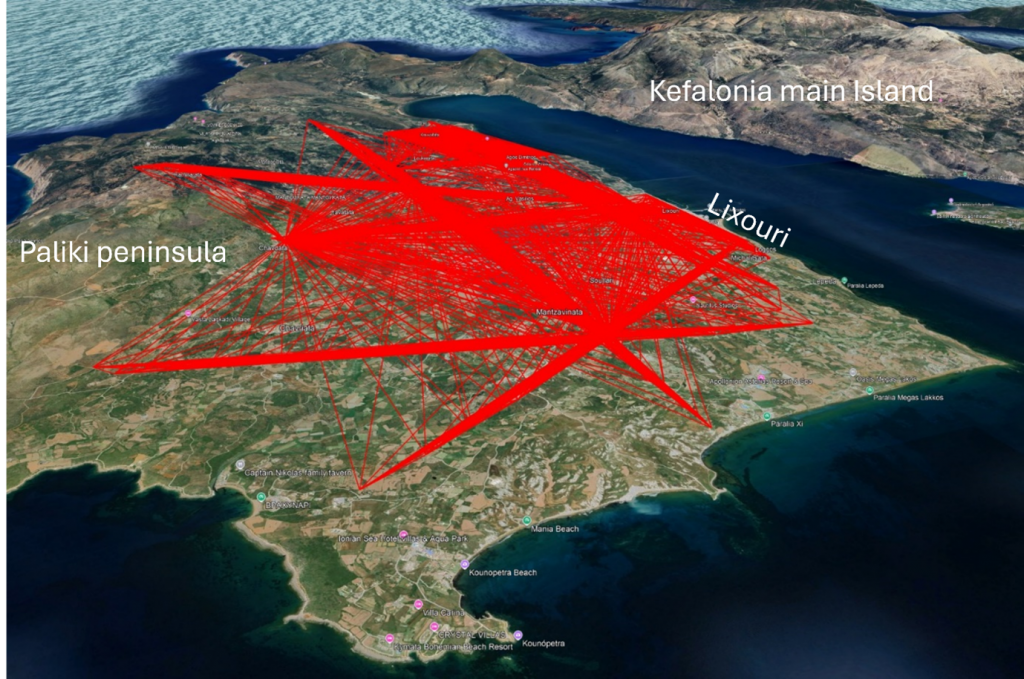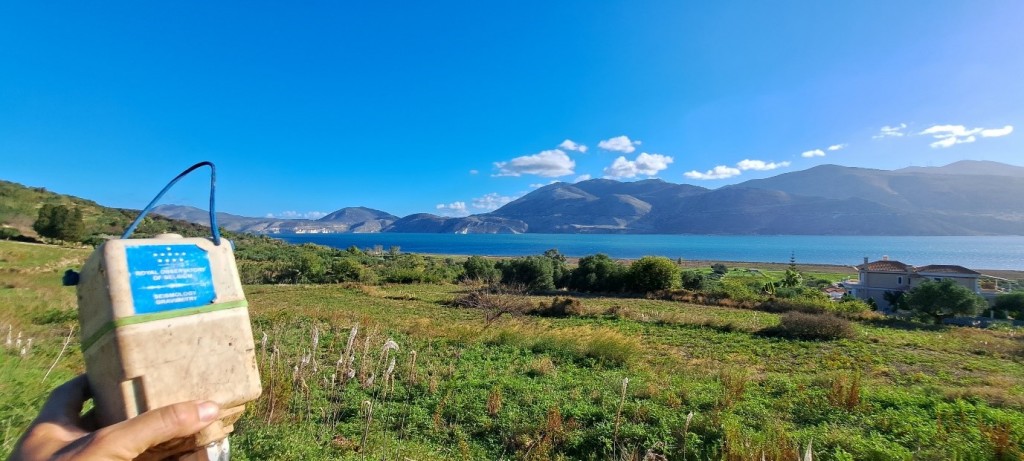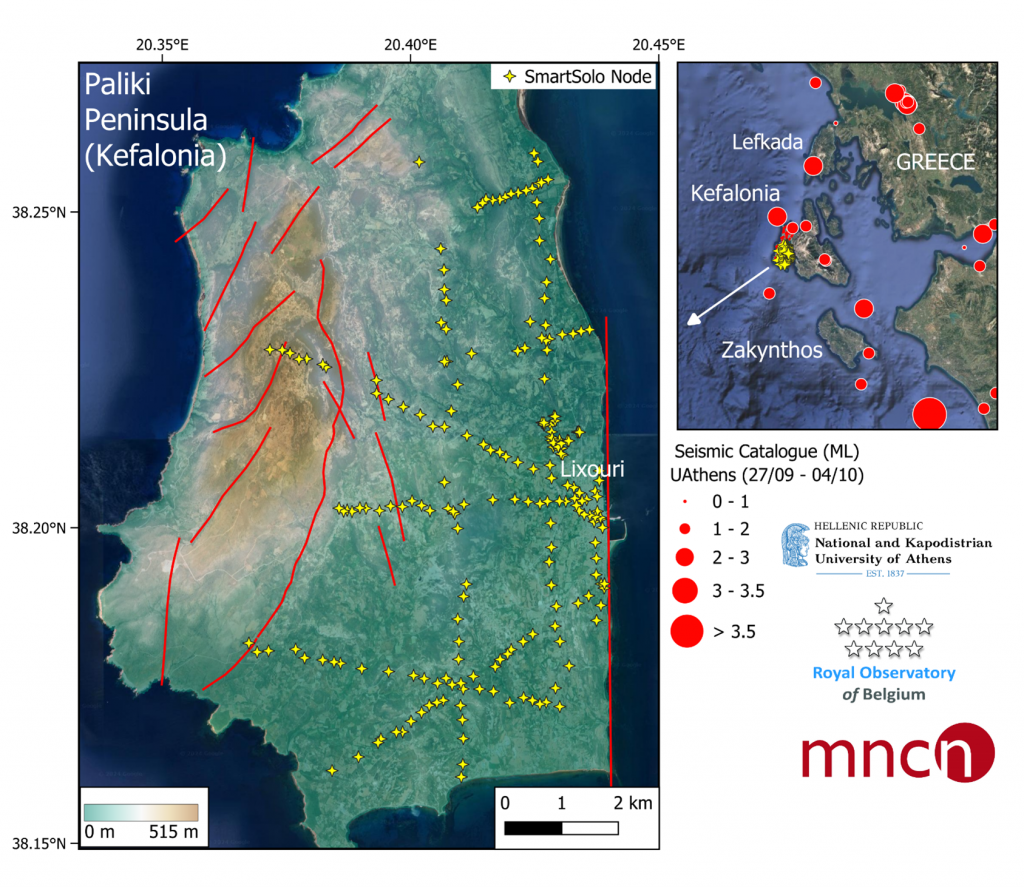Ambient seismic noise campaign to measure site effects of Lixouri and the Paliki peninsula, Kefalonia, Greece
The Royal Observatory of Belgium (ROB), the National and Kapodistrian University of Athens and the National Museum of Natural Sciences of Spain (MNCN-CSIC) joined forces in a field campaign to measure earthquakes and ambient seismic noise in the Paliki peninsula of the Ionian Island of Kefalonia in Greece to better understand the subsurface of this area.
The Ionian Islands Kefalonia and Lefkada in Greece have been repeatedly hit by moderate to large earthquakes and are situated in one of the most active seismotectonic zones of the Aegean. In Paliki, the western peninsula of the Island of Kefalonia, large earthquake amplification has been measured due to the presence of a subsurface soft sediment basin, but a geotechnical model explaining these amplifications is currently still lacking.
To develop a new 3D subsurface model and a detailed velocity model, the National and Kapodistrian University of Athens, the Royal Observatory of Belgium (ROB) and the National Museum of Natural Sciences of Spain (MNCN-CSIC) joined forces in a field campaign to deploy geophones in cross-profiles through the Paliki Peninsula.
The impetus of this fieldwork activity was initiated during the ‘8th International Conference on Historical Seismology, Paleoseismology and Earthquake Engineering’ held in Lixouri on 17–19/9/2023. Between Friday, 27 September 2024 and Friday, 4 October 2024, we successfully completed an ambient noise field study throughout the Paliki Peninsula.
Using 24 SmartSolo IGU-16HR 3C geophones, 3 SmartSolo IGU-BD3C-5LC broadband devices and two Tromino instruments, ambient noise measurements were carried out at 220 locations all over the Paliki Peninsula which resulted in ~ 3225 hours of ambient noise data. We installed one array and 9 profiles (total profile length of 50 km) crossing the island to detect the variation in bedrock depth and to measure site amplification when an earthquake would occur. Array and cross-correlation techniques, H/V Spectral Ratio analysis, and earthquake relocation techniques will be applied to better understand the impact of earthquakes on this area.

Raypaths between simultaneously installed geophones crossing the town of Lixouri and the Paliki Peninsula.
To our knowledge, it is the first time that such large-scale fieldwork has been performed on the Ionian Islands and the recorded data will stimulate new research studies and contribute significantly to the seismic protection of the Lixouri municipality on Paliki. A first look at the data already looks very promising as tens of small earthquakes were recorded, which beautifully propagated through the different installed networks, without having been identified by the permanent seismic network.

Installation team. Collaboration between the National and Kapodistrian University of Athens, the Royal Observatory of Belgium (ROB) and the National Museum of Natural Sciences of Spain (MNCN-CSIC)
The field research team included the seismologists Dr. Maria Jose Jimemez, Dr. Mariano Garcia Fernandez (scientific advisors of the OXE cooperation programs), and Dr. Nikolaos Sakellariou, all at MNCN-CSIC (Spain), Dr. Koen Van Noten and Dr. Raphael De Plaen from the ROB and Nikolaos Galanos, our local guide in Lixouri. The project was coordinated by Ms. Vasiliki Kouskouna, Em. Professor of Seismology at the University of Athens, and coordinator of the OXE cooperation projects between the University of Athens and the Municipality of Lixouri, under the supervision of the Mayor of Lixouri, Georgios Katsivelis, and, in close collaboration with CSIC, projects PIE 202330E132 and PIE 202330E137. The ROB provided in-kind contributions to support these projects with their seismic instrumentation.
In the future it will be important to continue this initiative with additional measurements to cover the entire peninsula of Paliki, which eventually will contribute to the understanding of the seismic risk of the area. Together with the study of the building vulnerability that already has been carried out in the framework of the OXE program, our study will make the assessment of the seismic risk of a future strong earthquake more accurate.
The research team expresses its sincere thanks to the residents of the Municipality of Lixouri, who welcomed us greatly and contributed to the smooth performance of the field campaign.

View on four consecutive earthquakes that occurred on the main island of Kefalonia on 2 October 2024 while our overnight array network of 26 stations near Lixouri was running.



